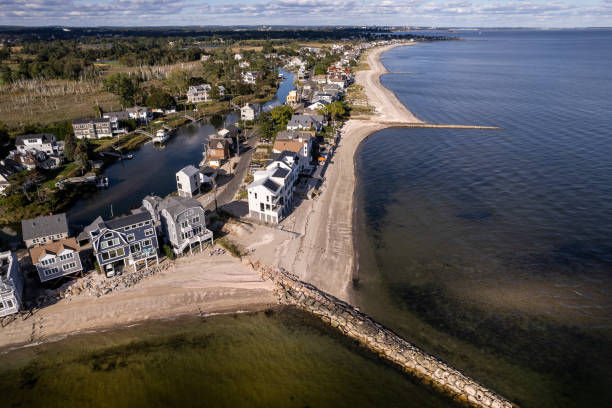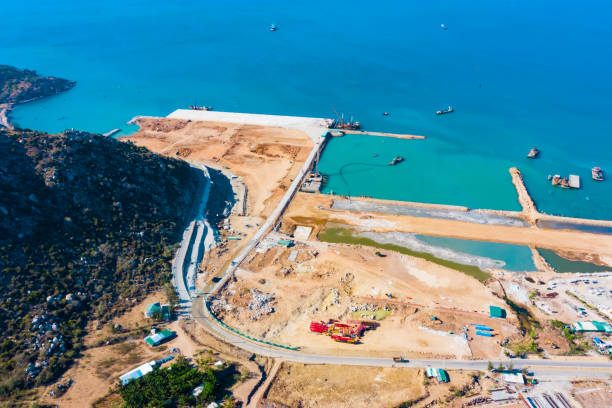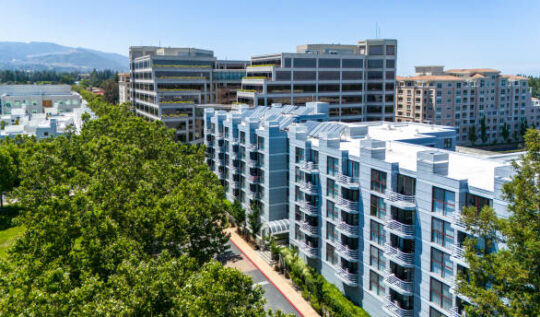Complete Guide on Coastal Development Permit: Los Angeles City Planning
Getting a project approved near the California coast isn’t like getting approval anywhere else. If you’re planning to build, renovate, or even remodel property near the beach—or in any part of California’s coastal zone—you’re likely going to need something called a Coastal Development Permit (CDP).
Table of Contents
ToggleAt JDJ Consulting Group, we help property owners, developers, restaurant groups, and real estate investors understand the red tape that comes with coastal planning. This guide breaks down what a CDP is, when you need one, how to get it approved, and why having the right team on your side can save months of delay and thousands in cost.
Understanding Why Coastal Development Permits Matter in California
California’s coastline isn’t just beautiful—it’s also tightly regulated. That’s because coastal areas are home to sensitive ecosystems, public access routes, and flood-prone land. The California Coastal Act, passed in 1976, made it mandatory for most types of development in the coastal zone to get approval first. That approval comes in the form of a Coastal Development Permit.
This isn’t just about beachfront homes. Even projects several miles inland may still fall under the rules if they’re in the mapped Coastal Zone. Without the right permit, even routine upgrades can get hit with stop-work orders, fines, or lawsuits.
Coastal Development Permit Application Process
So why does this matter to you?
Because whether you’re building a restaurant, subdividing land, or converting a property to mixed use, a Coastal Development Permit can decide whether your project moves forward—or gets stuck.
Who Needs a Coastal Development Permit?
And When You Might Not
One of the most common questions we hear at JDJ is: “Do I really need a coastal permit for my project?”
Here’s the short answer: If your project is located in California’s coastal zone and involves construction, demolition, land use changes, or land division—it probably does.
Here’s a basic table to help break it down:
| Project Type | Is a CDP Required? | Notes |
|---|---|---|
| New construction (residential/commercial) | Yes | Applies even to small homes or cafes |
| Demolition or major remodels | Yes | Often required if footprint or use changes |
| Deck or patio additions | Often | Especially if near cliffs or beach access |
| Lot line adjustments or land division | Yes | Triggers review for density and access issues |
| Interior remodels (no footprint change) | Sometimes no | Depends on local rules and project location |
In some cases, your project might qualify for an exemption or a waiver—but this isn’t automatic. Local governments or the Coastal Commission decide this based on how the development affects:
Environmentally Sensitive Habitat Areas (ESHAs)
Public access to the coast
Visual character of the coastline
Flood and erosion risk areas
At JDJ, we help determine if your project qualifies for these exemptions—and if not, how to create a plan that meets requirements and still moves forward on time.
The Coastal Development Permit Process: Step-by-Step Breakdown
Let’s walk through what actually happens when you need a Coastal Development Permit. From the outside, it might look like a bunch of forms, site plans, and hearing notices—but there’s a clear process behind it.
Here’s what a typical CDP journey looks like:
| Step | What It Involves | Handled By |
|---|---|---|
| Pre-application consultation | Review property location, project scope, zoning | JDJ + Client |
| Determine jurisdiction | Who issues the permit—local city/county or Coastal Commission? | JDJ |
| Prepare application materials | Site plans, project description, environmental forms | JDJ + Architect/Engineer |
| Submit to appropriate agency | Application goes to LCP or Coastal Commission | JDJ on client’s behalf |
| Agency review + public comment | Review of environmental, access, visual impacts | City, County, or Commission |
| Hearing (if needed) | Public hearing, especially for new or large developments | JDJ attends/supports client |
| Final decision or appeal | CDP is approved, denied, or appealed | JDJ manages appeal if necessary |
Most projects take 2–6 months for standard review. More complex or appealed developments can take longer—sometimes over a year. JDJ’s role is to speed up this timeline by managing paperwork, coordinating with agencies, and keeping your project compliant.
Key Policy Issues and Common Challenges in Coastal Development Permit Review
Even when a project looks great on paper, CDP reviews often hit roadblocks because of policy concerns. That’s why understanding the core issues that regulators care about can help you plan smarter from the start.
At JDJ Consulting Group, we don’t just submit permit forms—we help our clients design projects that already anticipate these coastal policy hurdles. That’s what keeps your application moving forward.
Here are the most common challenges developers face during CDP review—and how we help solve them.
Public Access Requirements
One of the top priorities of the California Coastal Act is to protect and expand public access to the beach. This means any project near trails, parks, or beach routes may be required to:
Preserve access routes through the site
Provide lateral or vertical easements
Avoid visual or physical barriers
Pay into public access or recreation funds
For example, if your development sits between the coast and the nearest public road, your plans may need to include a pedestrian path or view corridor. JDJ helps design access components that satisfy regulations without compromising your project’s design.
Sea Level Rise and Climate Resilience
In 2025, sea-level rise is no longer a distant future issue—it’s part of today’s permitting process.
The Coastal Commission now requires many applicants to assess how their project will be affected by:
Shoreline erosion
Rising tides
Coastal flooding
Saltwater intrusion
Depending on the project, this could mean:
Elevating structures
Using natural buffers like dunes or wetlands
Avoiding certain zones entirely
If your project is on a bluff, near a beach, or close to wetlands, JDJ will work with coastal engineers and planners to prepare a resilience strategy that satisfies review standards and keeps your investment safe long-term.

Visual Impacts and Neighborhood Character
The coast isn’t just about function—it’s about views. Projects can be denied or delayed simply because they’re too tall, too modern, or out of place with neighboring homes and landscapes.
CDP reviewers often assess:
Building height and rooflines
Color and material palettes
Landscaping buffers
Impact on scenic highways or overlooks
That’s why we help our clients integrate visual simulations, renderings, and elevation studies to show that your design fits the context.
Environmentally Sensitive Habitat Areas (ESHAs)
If your site is located near dunes, bluffs, wetlands, or coastal scrub, it may fall under an Environmentally Sensitive Habitat Area (ESHA) designation. Building in or near an ESHA is extremely restricted—and triggers strict review.
Projects in these zones often require:
Detailed biological studies
Mitigation plans
Setbacks from protected zones
Reduced footprint or relocation
Here’s a quick table to illustrate how different sites impact CDP complexity:
| Site Type | Review Complexity | Common Mitigation Requirements |
|---|---|---|
| Urban infill (inside LCP city) | Low | Visual/design consistency, possible parking changes |
| Residential blufftop lot | Medium to high | Drainage plan, visual impact study, setback lines |
| Near coastal wetland or ESHA | High | Biology reports, habitat buffer zones, limits on use |
| Beachfront commercial project | Very high | Public access easements, FEMA review, elevation |
By understanding these issues early, JDJ helps our clients design smarter, submit stronger applications, and avoid last-minute redesigns.
Technical and Environmental Considerations in Coastal Projects
Getting a Coastal Development Permit isn’t just about zoning—it’s about engineering, environment, and long-term resilience. At JDJ Consulting Group, we work closely with architects, engineers, and environmental consultants to make sure every project meets both design goals and coastal regulations.
This section breaks down the technical details you’ll need to consider—and how JDJ helps tie everything together in a way agencies understand and approve.
Engineering for Coastal Conditions
Coastal properties come with unique risks—from salt corrosion and storm surge to erosion and unstable slopes. That’s why proper engineering is critical in the early design phase.
Here are just a few elements that often need special attention:
Drainage Systems: To avoid runoff into sensitive areas like wetlands or bluffs
Slope Stability: For properties on cliffs or near landslide-prone zones
Structural Elevation: Especially in FEMA flood hazard areas
Foundation Type: Pile-supported systems are sometimes required in sandy or eroding areas
At JDJ, we collaborate with engineers to ensure plans not only meet code but also satisfy Coastal Commission guidelines. We also help coordinate required technical reports—from wave run-up studies to coastal engineering assessments.
Environmental Studies and CEQA Compliance
Many coastal projects also trigger review under CEQA (California Environmental Quality Act). That means your CDP application might need to include an Initial Study or even a full Environmental Impact Report (EIR).
Environmental documents often cover:
Habitat surveys and species analysis
Traffic and noise impacts
Cultural resource findings
Air and water quality concerns
We help clients anticipate CEQA triggers and build a review strategy that works alongside the CDP process—not against it. That can often mean pairing public notice periods or sequencing documents to save time.
Integrating Coastal Requirements with Smart Development
More and more, agencies expect projects to address climate resilience, low-impact development (LID), and green building standards.
Here are ways smart design can give your project a competitive edge:
Permeable paving to reduce stormwater runoff
Native landscaping to stabilize soil and support local species
Energy-efficient systems that support long-term sustainability
Adaptable site plans that allow for future sea-level changes
Rather than treating these features as “extras,” we work them into the core site strategy—helping clients get faster approvals and better community support.

Coordinating with Other Permits and Agencies
Coastal projects often don’t stand alone. They may also need permits or reviews from:
U.S. Army Corps of Engineers (for shoreline work)
State Water Resources Control Board (for drainage/stormwater)
California Department of Fish and Wildlife (for habitat)
Local Planning Departments (for height, parking, setbacks)
JDJ acts as a liaison—managing timelines, filing documents, and communicating across agencies—so you don’t lose time in the shuffle.
How JDJ Consulting Group Helps Clients Navigate the Coastal Permit Process
Securing a Coastal Development Permit in California is not a do-it-yourself process. It involves navigating land use laws, environmental reviews, and public hearings—each with its own timeline and requirements.
That’s where JDJ Consulting Group comes in.
We specialize in helping developers, property owners, investors, and business operators (especially restaurants and mixed-use projects) secure the permits they need to build confidently in coastal zones. Here’s how we make the difference.
Strategic Feasibility Analysis Before You Buy or Build
Before you invest in a site or move forward with development, JDJ helps you understand what’s realistically possible under the Coastal Act and local zoning codes.
We conduct:
Zoning and overlay reviews
Coastal zone boundary checks
Access and topography analysis
Permit pathway forecasting
This helps you avoid buying a property with limitations that could derail your goals—or worse, delay you for years.
We’ll give you a clear go/no-go strategy—so you can make smart decisions before spending thousands on design or entitlements.
Full-Service Permit Management and Application Support
Once you’re ready to move forward, JDJ takes care of the entire CDP process—from documentation to final approval. Our services include:
Coordinating with architects, engineers, and legal teams
Preparing complete application packages with project descriptions, exhibits, and environmental forms
Managing communication with local governments or the California Coastal Commission
Representing clients in hearings, site visits, and public meetings
Responding to agency comments and facilitating revisions if needed
We understand how each jurisdiction interprets the Coastal Act, and we tailor your submittal accordingly—whether you’re in Santa Monica, Malibu, Pacific Palisades, Long Beach, or other coastal cities.
Avoiding Delays, Appeals, and Legal Risks
Most CDP delays happen because applicants don’t address environmental concerns, access requirements, or neighborhood opposition early on. That’s why JDJ builds these elements into the plan from day one.
We also:
Pre-negotiate easements or setbacks to avoid rejection
Manage CEQA timelines in parallel with CDP milestones
Prepare visuals and storyboards to win support at hearings
Work proactively with Coastal Commission staff to reduce the chances of appeal
By anticipating objections before they come up, we help avoid lengthy delays or de novo appeals—especially in high-profile zones like Venice, Marina del Rey, or San Diego’s coastal overlay areas.
Proven Results Across Project Types
Whether it’s outdoor dining near the beach, small-scale multifamily housing, or an adaptive reuse of an existing structure, JDJ brings deep experience in California’s coastal permitting system.
Sample JDJ Project Types in Coastal Zones:
| Project Type | Location | Our Role |
|---|---|---|
| Restaurant patio expansion | Santa Monica coastal overlay | CDP strategy, design input, permit expediting |
| Single-family renovation | Pacific Palisades | ESHA buffer analysis, CDP documentation |
| New mixed-use development | Long Beach | Full entitlement & CDP coordination |
| Boutique hotel upgrade | Venice coastal zone | Visual impact study + Coastal Commission review |
| Blufftop residential project | Encinitas | Drainage plan, slope report, appeals support |
Our role is to simplify complexity—so you can focus on your project, not paperwork.
Real-World Case Studies: How CDPs Have Been Approved—And Blocked
Even well-funded, well-designed coastal projects can get rejected if they fail to meet the California Coastal Act’s goals. That’s why strategy matters just as much as design.
Below are real-world examples of projects that navigated the Coastal Development Permit process—with and without expert support. These case studies show where things go right, and where they can go wrong. They also reveal how JDJ Consulting Group adds value at each step.

Case Study 1: Outdoor Dining Expansion in Coastal Overlay Zone – Santa Monica
Project: Convert a small parking area into a raised patio for a coastal restaurant
Challenge: Located within Santa Monica’s Coastal Zone overlay, the project triggered CDP requirements due to a change in use and potential impact on coastal access.
JDJ’s Solution:
Conducted a pre-application review with the city’s planning department
Coordinated with design team to ensure ADA access, landscape buffers, and stormwater compliance
Prepared a comprehensive project narrative and visual impact exhibit for staff and public review
Managed the hearing process and negotiated revised patio size to maintain public path visibility
Result: CDP approved within 90 days without appeal. The restaurant expanded seating capacity and improved curb appeal during the peak tourist season.
Case Study 2: Single-Family Blufftop Build Without Early ESHA Review – Laguna Beach
Project: Custom home on a steep bluff in Laguna Beach
Challenge: The applicant submitted CDP plans without a biological report, unaware that part of the site overlapped an Environmentally Sensitive Habitat Area (ESHA).
Result:
Coastal Commission staff flagged the omission and requested additional studies
The project was delayed over 10 months
The client had to pay for a redesigned footprint, habitat mitigation plan, and new geotechnical surveys
Lesson Learned: Early environmental review is critical. If this client had partnered with a consulting firm like JDJ, the ESHA overlay would have been identified during due diligence—saving months and thousands in rework.
Case Study 3: Mixed-Use Infill Project Near Transit Corridor – Long Beach Coastal Zone
Project: 3-story mixed-use residential and retail development in a walkable downtown area
Challenge: The site was in the Coastal Zone and had a nearby historic district, raising visual impact and density concerns.
JDJ’s Role:
Verified that the city had a certified Local Coastal Program (LCP), so the CDP would be handled locally—not by the Coastal Commission
Integrated smart-growth principles like reduced parking ratios and transit proximity
Presented 3D visualizations showing view corridors were preserved
Facilitated letters of support from local business owners and nearby residents
Result: Project approved with minor modifications. The developer received a density bonus and began construction within six months of initial application.
Case Study 4: Appeal Filed by Coastal Advocacy Group – Marina del Rey
Project: Remodel and partial expansion of an aging apartment complex
Challenge: Although the project complied with zoning and CEQA, a local advocacy group filed an appeal to the California Coastal Commission citing potential “cumulative access impacts.”
What Happened:
The local CDP was overturned on appeal
The Commission requested additional studies and public access improvements
The developer had to reduce unit count and add a pedestrian walkway to secure approval
Takeaway: Even compliant projects can be appealed. JDJ helps prepare mitigation plans and stakeholder outreach in advance to reduce the likelihood of appeals—or position your project for success if one occurs.
Summing it Up!
Getting a Coastal Development Permit is an important part of building near California’s coast. It helps protect the environment and keeps your project on track with the law. With the right guidance, the process doesn’t have to be stressful.
Need help with your coastal project?
Contact JDJ Consulting Group today—we’ll help you plan smart, stay compliant, and move forward with confidence. Call us at (818) 233-0750 or contact us online to get your permit hassle-free.
CDP Time & Cost Estimator
Ready to Start Your Coastal Project?
Let JDJ Consulting Group guide you through the Coastal Development Permit process from start to finish.
Contact Us NowFrequently Asked Questions (FAQs) About Coastal Development Permits
What is a Coastal Development Permit (CDP)?
A Coastal Development Permit is a regulatory approval required in California for most development projects within the state’s legally defined coastal zone. The permit ensures that the proposed project complies with the California Coastal Act, especially regarding environmental protection, public access, and coastal preservation.
Key facts:
Required for construction, demolition, grading, and some remodels in the coastal zone
Reviewed by either the local jurisdiction (if certified) or the California Coastal Commission
Protects scenic, environmental, and public access values of California’s coast
Do I need a Coastal Development Permit for my project?
If your property is located within the California coastal zone and you’re planning to build, modify land, or change land use, you likely need a CDP. Exemptions exist but must be verified by local planning or the Coastal Commission.
Projects typically requiring a CDP:
New construction (residential or commercial)
Changes in land use or lot lines
Renovations affecting the structure’s footprint or use
Work in Environmentally Sensitive Habitat Areas (ESHAs)
What is the coastal zone in California?
The coastal zone in California is a legally defined area along the coast that extends from the shoreline up to five miles inland in some places. It includes beaches, wetlands, blufftops, and coastal towns—each subject to Coastal Act rules.
Coastal zone boundaries include:
Beachfront and bluff areas
Wetlands and watersheds connected to the ocean
Urban and suburban land within mapped boundaries
May vary based on local topography and city planning
What are the effects of coastal development?
Unregulated coastal development can cause erosion, habitat loss, and blocked public access, while well-managed development supports local economies and sustainability. Coastal Development Permits help balance these outcomes.
Negative effects include:
Shoreline erosion and infrastructure risk
Habitat destruction (marine and terrestrial)
Disruption of public access routes
Increased flooding from sea level rise
What are the advantages of coastal development?
Coastal development offers economic and recreational benefits when done responsibly. With strong planning, it can support community growth and resilience.
Benefits of thoughtful coastal development:
Boosts tourism and local business opportunities
Creates jobs in construction and real estate
Adds amenities like parks and restaurants
Supports walkable, mixed-use communities with ocean access
What are the advantages of coastal management?
Coastal management protects natural environments, guides sustainable growth, and reduces risks from sea level rise. It’s the foundation of CDP policy in California.
Why coastal management matters:
Maintains ecological balance
Preserves beach and ocean access
Reduces property damage from erosion and floods
Increases long-term community resilience
Why is it called coastal development?
It’s called “coastal development” because it involves land use changes near the coastline—typically where land meets the sea. These areas are sensitive and heavily regulated.
Key characteristics of coastal development:
Takes place within legally defined coastal zones
Involves residential, commercial, or public-use projects
Requires extra approvals like CDPs for compliance with state law
What are the types of coastal infrastructure?
Coastal infrastructure refers to both public and private structures built along or near the coast to serve human activity or environmental management.
Examples of coastal infrastructure include:
Seawalls, breakwaters, and groynes
Boardwalks, piers, and harbors
Drainage and flood protection systems
Public trails, restrooms, and beach access paths
What are coastal areas?
Coastal areas are geographic regions near the shoreline, often defined by proximity to the ocean. In California, they include more than just beaches—they can extend several miles inland.
Features of coastal areas:
Often include beaches, bluffs, wetlands, and dunes
Host both natural habitats and developed communities
Are subject to state laws and Coastal Commission oversight
How does JDJ Consulting Group help with Coastal Development Permits?
JDJ Consulting Group helps clients secure Coastal Development Permits by providing strategic planning, permit expediting, and agency coordination from start to finish.
Our services include:
Feasibility studies and zoning research
Preparation and submittal of full CDP applications
Environmental review coordination (e.g. CEQA, ESHA studies)
Public hearing representation and appeal defense
Project alignment with Coastal Act, LCPs, and smart growth principles






Los Angeles Permit Timeline for Multifamily Projects | 2025 Guide
August 8, 2025
[…] Overlay zones – Some areas have extra rules, like historic zones or coastal regulations. […]
Is Renting in Los Angeles Worth It in 2025? | JDJ Consulting Group
August 13, 2025
[…] Coastal areas like Santa Monica, Venice, and Playa Vista are over $4,000 for a two-bedroom. […]
Real Estate Consulting Companies in Los Angeles: JDJ Consulting
August 20, 2025
[…] regulations covering hillside areas, coastal zones, and wildfire […]
Why Buildable Area Test-Fits Are Essential for LA Real Estate
August 22, 2025
[…] the full story. Unfortunately, zoning text rarely tells you the whole picture. Hillside overlays, coastal zones, design guidelines, and infrastructure limits can all shrink the usable […]